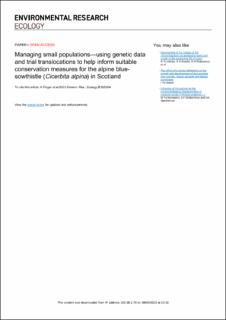Managing small populations—using genetic data and trial translocations to help inform suitable conservation measures for the alpine blue-sowthistle (Cicerbita alpina) in Scotland
| dc.contributor.author | Finger, Aline | |
| dc.contributor.author | Smedley, M. | |
| dc.contributor.author | Halley, Duncan John | |
| dc.contributor.author | Frachon, N. | |
| dc.contributor.author | Ahrends, A. | |
| dc.coverage.spatial | Scotland | en_US |
| dc.date.accessioned | 2023-08-18T06:48:13Z | |
| dc.date.available | 2023-08-18T06:48:13Z | |
| dc.date.created | 2023-08-08T14:16:24Z | |
| dc.date.issued | 2023 | |
| dc.identifier.issn | 2752-664X | |
| dc.identifier.uri | https://hdl.handle.net/11250/3084717 | |
| dc.description.abstract | Habitat fragmentation is causing an increasing amount of species loss around the world and creates problems at the population level. Many species are left as only small and isolated populations, which are vulnerable to genetic erosion and inbreeding depression. Here we present a study on the alpine blue-sowthistle (Cicerbita alpina). Due to intensive grazing the species is very rare in Scotland, where it occurs at only four small, montane sites, has never been reported to reproduce and is in need of conservation interventions. As the species can grow clonally it is unknown how many individuals remain and whether populations are affected by genetic isolation. We (1) quantified genetic diversity, inbreeding and between-population differentiation in Scotland and Norway using 15 microsatellite loci, and (2) experimentally translocated plants to new sites. Genetic diversity in Scotland was low (HE: 0.35; Allelic Richness: 1.84; 4 sites) compared to Norway (HE: 0.52; Allelic Richness: 2.56; 5 sites). The transplants were able to grow at new sites and are therefore not restricted to steep, montane ledges. While grazing is likely to be the main factor preventing range expansion, long-term genetic isolation has possibly further lowered population viability. To avoid local extinction of this species, conservation translocations and genetic rescue might be appropriate conservation interventions, but this needs to be further tested in a controlled environment and away from wild sites to avoid potential risks of outbreeding depression. conservation genetics, translocations, gene flow, microsatellites, grazing, Scotland, Asteraceae | en_US |
| dc.language.iso | eng | en_US |
| dc.rights | Navngivelse 4.0 Internasjonal | * |
| dc.rights.uri | http://creativecommons.org/licenses/by/4.0/deed.no | * |
| dc.subject | conservation genetics | en_US |
| dc.subject | translocations | en_US |
| dc.subject | gene flow | en_US |
| dc.subject | microsatellites | en_US |
| dc.subject | grazing | en_US |
| dc.subject | Scotland | en_US |
| dc.subject | Asteraceae | en_US |
| dc.title | Managing small populations—using genetic data and trial translocations to help inform suitable conservation measures for the alpine blue-sowthistle (Cicerbita alpina) in Scotland | en_US |
| dc.title.alternative | Managing small populations—using genetic data and trial translocations to help inform suitable conservation measures for the alpine blue-sowthistle (Cicerbita alpina) in Scotland | en_US |
| dc.type | Peer reviewed | en_US |
| dc.description.version | publishedVersion | en_US |
| dc.rights.holder | © 2023 The Authors | en_US |
| dc.subject.nsi | VDP::Økologi: 488 | en_US |
| dc.subject.nsi | VDP::Ecology: 488 | en_US |
| dc.source.volume | 2 | en_US |
| dc.source.journal | Environmental Research: Ecology | en_US |
| dc.identifier.doi | 10.1088/2752-664X/acdef9 | |
| dc.identifier.cristin | 2165649 | |
| dc.source.articlenumber | 025004 | en_US |
| cristin.ispublished | true | |
| cristin.fulltext | original |
Tilhørende fil(er)
Denne innførselen finnes i følgende samling(er)
-
Publikasjoner fra CRIStin - NINA [2364]
-
Scientific publications [1392]
Vitenskapelige artikler, kapitler og monografier i Open Access.

